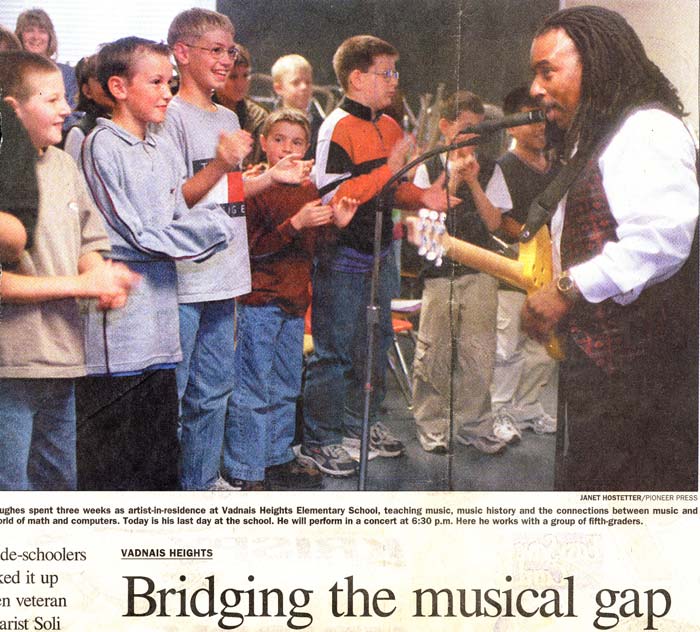Bridging the Musical Gap
It's Trends & Lifestyles
Written by John Welsh
Staff Writer
St. Paul Pioneer Press
Welcome
Soli Hughes, musician in the Twin Cities scene for three decades, shows the sparkling silver platform boots that nearly reach his knees to the students of Vadnais Heights Elementary School.
They take one look and say "Spice Girls."
Not quite, Hughes tells them.
Actually, the shoes are from the 1970s when Hughes played guitar with the band Crystal Haze, a group with an Earth, Wind and Fire sound and clothing style that scored a few hits in the Upper Midwest in its day.
For Hughes, those boots that scream "disco" provide a nice teaching opportunity to show that music did not begin with 'N Sync, Christina Aguilera and the Backstreet Boys.
Hughes, whose credits include stints with The Sounds of Blackness and Moore by Four, completes a three-week artist-in-residence today at Vadnais Heights. Besides a little music history, Hughes also taught the school's 500 students about math and its importance, both in making music and in the life of the musician, as well.
"I want to show them that musicians just aren't people who play instruments and look cool," he said. "I want them to understand the history and the why and how things work."
The kids seemed to enjoy it. During an hour-long session this week, students rushed to the front row of seats and eagerly raised their hands or shouted answers to questions.
"Do you know where this is from?" asked Hughes after he pulled down the world map and played notes from his guitar.
"It's a sitar. From India," said Hughes, who had hooked his guitar through the synthesizer so it indeed sounded like a sitar.
"This music may sound strange to us, but to someone from India it sounds like this," he said, as he finished his sentence with some straightforward rock chords after hitting a computer switch to make the guitar sound like a guitar.
During his sessions with students, Hughes frequently made references to math and its importance in music. Sometimes it came when he talked about the binary digital language of computers. Another time, he ran through an exercise with students where they had to work out a financial budget for a music group's trip to New York City, figuring out how much to spend on food, advertising and other expenses.
"I try to make realistic connections," Hughes said. "One thing I want to do is to bridge the gap between professional musician and an educator. A lot of music educators haven't been on a tour or haven't been a working musician."
School principal Chuck Andrews said he liked the way Hughes could weave in the math with the music in a way that clicked with students.
"It was fantastic. The students talked about it - when they get off the bus, in the playground and in lunch," Andrews said.
